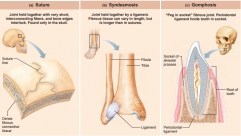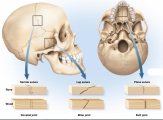Joint Classification: Difference between revisions
No edit summary |
No edit summary |
||
| Line 26: | Line 26: | ||
== Cartilaginous Joints == | == Cartilaginous Joints == | ||
Cartilaginous joint, '''amphiarthrosis''', or '''amphiarthrodial''' joint , two bones are linked by cartilage | |||
T<u>wo types of cartilaginous joints:</u> | |||
* Synchondroses | |||
* Symphyses | |||
==== '''A - Synchondroses''' ==== | |||
A bar or plate of hyaline cartilage unites the bones at a synchondrosis , The most common examples of synchondroses are <u>Temporary joints in the epiphyseal plates in children</u> which Bind epiphysis to diaphysis and <u>First rib attachment to sternum</u> while Other costal cartilages joined to sternum by synovial joints | |||
Revision as of 19:24, 20 August 2017
A joint or articulation (or articular surface) is the connection made between bones in the body which link the skeletal system into a functional whole.[1][2][3] They are constructed to allow for different degrees and types of movement. Some joints, such as the knee, elbow, and shoulder, are self-lubricating, almost frictionless, and are able to withstand compression and maintain heavy loads while still executing smooth and precise movements.[3] Other joints such as sutures between the bones of the skullpermit very little movement (only during birth) in order to protect the brain and the sense organs.[3] The connection between a tooth and the jawbone is also called a joint, and is described as a fibrous joint known as a gomphosis. Joints are classified both structurally and functionally.[4]
The science of joint structure ,function and dysfunction is called Arthrology
Fibrous joints[edit | edit source]
In fibrous joints ,synarthrosis, or synarthrodial joint , the bones are joined by fibrous tissue, namely dense fibrous connective tissue, and no joint cavity is present. The amount of movement allowed depends on the length of the connective tissue fibers uniting the bones. Although a few are slightly movable, most fibrous joints are immovable.
The three types of fibrous joints are sutures, syndesmoses, and gomphoses.
A - Sutures[edit | edit source]
immobile or slightly mobile fibrous joints in which short collagen fibers bind the bones of the skull to each other
Sutures can be classified as:
- Serrate: interlocking wavy lines ( Coronal, sagittal, and lambdoid sutures )
- Lap (squamous): overlapping beveled edges ( Temporal and parietal bones )
- Plane (butt): straight, nonoverlapping edges ( Palatine processes of the maxillae )
B - Gomphoses[edit | edit source]
attachment of a tooth to its socket , Held in place by fibrous periodontal ligament which consist of Collagen fibers attach tooth to jawbone and Allows the tooth to move a little under the stress of chewing
D - Syndesmoses[edit | edit source]
a fibrous joint at which two bones are bound by long collagen fibers , the sepration between the bones and the length of the fibers gives these joints more mobility than a suture and gomphoses
Example of a very mobile syndesmosis: interosseus membrane joining radius to ulna allowing supination and pronation
Example of a less mobile syndesmosis: joint between tibia to fibula
Cartilaginous Joints[edit | edit source]
Cartilaginous joint, amphiarthrosis, or amphiarthrodial joint , two bones are linked by cartilage
Two types of cartilaginous joints:
- Synchondroses
- Symphyses
A - Synchondroses[edit | edit source]
A bar or plate of hyaline cartilage unites the bones at a synchondrosis , The most common examples of synchondroses are Temporary joints in the epiphyseal plates in children which Bind epiphysis to diaphysis and First rib attachment to sternum while Other costal cartilages joined to sternum by synovial joints








